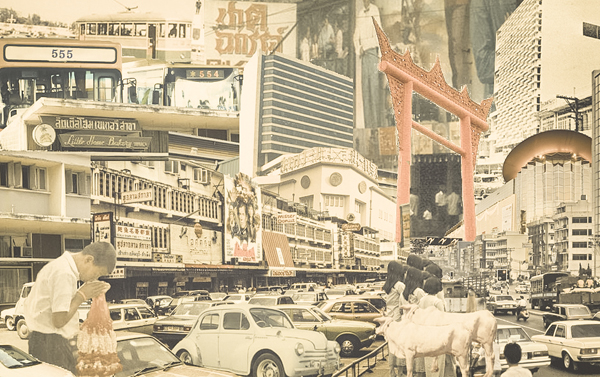1. Ratchadamri Road
King Rama V decided to build this road in 1902, as he believed future transportation in Bangkok would rely on cars.
Yeah, he was only too right.
2. Paholyothin Road
The image of three young girls selling flower garlands on the street of Paholyothin in 1970 reflects how little things have changed.
3. Bus
Before speedy Bus No.8 existed, the first route was started by Phraya Pakdee Norasen (Lert) in 1885, running in the Pratunam area. The first buses In Thailand were white, pulled by horses and commonly known as “Mr. Lert’s white bus.”
4. Taxi
Originally called “mile cars,” taxis were introduced to Bangkok in the 1920s by Phraya Thephassadin na Ayutthaya, leader of the Defence Attache’ Thai ambassadors.
He first let soldiers drive his Austin cars around Bangkok to earn money. The fare was 15 satang per mile (100 satang = 1 baht), but he finally had to shut down the business due to low profit.
Twenty years later, the first taxi company was founded and became a success with a fare of THB2 per kilometer. The first taxi model was a Renault, so of course people back then simply called the cabs “Renault.”
5. Pak Khlong Talat
This crowded, fresh market opened 200 years ago in the age of King Rama I. When Bangkok was first established, many canals were dug up as a large community started right there at Talat canal.
Pak Khlong Talat was originally the center of fish trading, with seafood directly transported from the Tha Chin River, a tributary of the Chao Phraya. Today it’s known for its fresh flowers and vegetables.
6. Pratunam
Pratunam means “water gate” in Thai. In King Rama V’s age, the area was actually a water gate of the Saen Saeb canal. Later Petchaburi road was built across the area, even though it has been hundreds of years, locals and many maps still refer to the road as “New Petchaburi Road” or “Petchaburi Tat Mai” in Thai.
7. MBK
Two hundred years ago Mahboonkrong or MBK was a large pond with beautiful lotus flowers and a personal leisure spot of King Rama V. His majesty was fond of the area so much that he built a temple nearby, which explained the story of Wat Pathum Wanaram, the temple located in the middle of the Pathumwan business district.
8. Siam Paragon
The land Siam Paragon was built over previously belonged to Siam Intercontinental Hotel. Eight years ago it officially opened as one of the biggest shopping centers in Asia.
9. Siam Square
Doesn’t look that different now, but back in the ‘60s Siam Square was called “Pathumwan Square” to match the name of its district. Before the shopping center was established, the land was made home to a slum community until a fiery “accident” forced them to relocate to make way for commercial development.
Many shops and restaurants in Siam Square have been operating since 1962, including the architecturally stunning-yet-doomed Scala Theater, Shark’s Fin Restaurant and the first branch of Mister Donut in Thailand.
10. The Nightingale Shopping Mall
The shopping destination of the hi-so girls of another generation, The Nightingale was the first department store in Bangkok. Located at Pahurat intersection in the Phra Nakhon district, the mall was opened in 1930 by Natti Niyomwanit, a famous lawyer and businessman. The mall is still open today and has become a source of vintage finds and a museum for younger generations to observe old-time luxury.
They say the mannequins currently displaying clothes are over 60 years old, but still younger than the current mall manager.
11. Sala Chalermkrung Royal Theatre

Considered the “Hollywood of Thailand” during the 1930s, Sala Chalermkrung Royal Theatre brought together famous directors, actors and voice-over artists in one place. The luxurious theatre showed only first-class films, mostly from Hollywood, and became a hangout joint for wealthy people educated abroad.
Chalermkrung seats more than 1,000 and was the first cinema in Asia with a chilled-water system.
12. Giant Swing
Although most would name Siam Paragon or Silom Road as the center of Bangkok, the Giant Swing in Sao Chingcha district was meant to be the center of the capital city since the Rattanakosin era.
Nicknamed “the navel of city,” the Giant Swing is surrounded by vintage architecture and office buildings which testify to its glory days.
13. Sala Daeng
Saladang had always been a large empty field until a group of Danish businessmen demanded a concession to build a train route in 1893. A train station was later built in the field with its roof painted in solid red, standing out among the green scenery. Ever since, locals refer to this area as Sala Daeng,which means “red pavillion.”
14. Bang Kapi
The Bang Kapi district is said to be derived from the Arabic word “kappiya” due to a large Muslim community which resided in the area.
15. Little Home Bakery
Little Home Bakery, one of the oldest and most well-known bakeries in Thailand, was founded by a Filipino housewife in 1951. She first started baking and selling her famous pancakes and coconut cake in her own home before establishing the first stand-alone shop on Thonglor Road in 1969, which has been renovated and is still open until today.
16. Happy Land
The first theme park in Thailand, Happy Land first opened in 1973 and was a sweet escape of low-to-middle-class children in the capital’s outskirts. Happy Land lived up to its name for a time, until children began to die in the poorly maintained rides. The park had to close down in 1979 and has been replaced with a fresh produce market.
Read the full tale of Happy Land, Murder and mayhem at Bangkok’s haunted amusement park.
Source: Sanook




